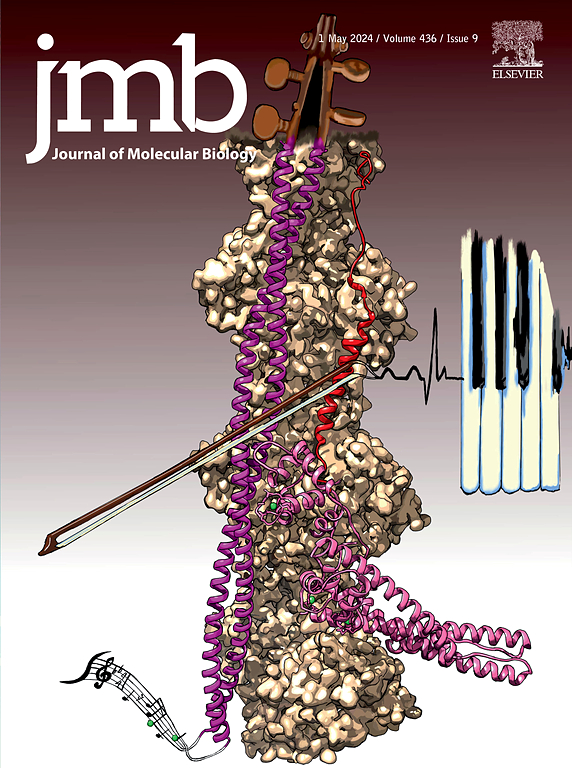The Evolution and Implications of the Inosine tRNA Modification
IF 4.5
2区 生物学
Q1 BIOCHEMISTRY & MOLECULAR BIOLOGY
引用次数: 0
Abstract
Ever since the legendary publication by Francis Crick in JMB introducing the wobble hypothesis in 1966, inosine has been a permanent part of molecular biology. This review aims to integrate the rich array of novel insights emerging from subsequent research on the adenine-to-inosine modification of tRNA, with an emphasis on the results obtained during the last 5 years. Both the grand panorama of 4 billion years of evolution of life and the medical implications of defects in inosine modification will be reviewed.
The most salient insights are that: (1) inosine at position 34 (the first position in the anticodon) is not universally present in the tree of life; (2) in many bacteria just a single homodimeric enzyme (TadA) is responsible for both tRNA inosine modification and mRNA inosine modification; (3) rapid progress is currently being made both in the molecular understanding of the heterodimeric ADAT2/ADAT3 enzyme responsible for inosine modifications in eukaryotes and in experimental capabilities for monitoring both the cytoplasmic tRNA pool and their modifications; (4) for selected tRNAs, inosine modification at position 37 has been demonstrated but this modification remains under-studied; (5) modification of tRNAs known to contain inosine can be incomplete; (6) the GC content of the T-stem is of great importance for wobble behavior, including wobbling behavior of inosine; and (7) the tRNA inosine modification is of direct relevance to human disease.
In summary, research on inosine continues to yield important novel insights.

肌苷tRNA修饰的进化及其意义。
自从Francis Crick于1966年在JMB上发表了具有传奇色彩的文章,介绍了摆动假说以来,肌苷一直是分子生物学的永久组成部分。这篇综述旨在整合tRNA腺嘌呤到肌苷修饰的后续研究中出现的丰富的新见解,重点是在过去5年中获得的结果。将回顾40亿年生命进化的全景和肌苷修饰缺陷的医学意义。最突出的见解是:(1)34位肌苷(反密码子的第一个位置)在生命树中并不普遍存在;(2)在许多细菌中,只有一种同型二聚体酶(TadA)同时负责tRNA肌苷修饰和mRNA肌苷修饰;(3)对真核生物中负责肌苷修饰的异二聚体ADAT2/ADAT3酶的分子理解和监测细胞质tRNA池及其修饰的实验能力都取得了快速进展;(4)对于选定的trna,已经证实在第37位有肌苷修饰,但这种修饰仍有待研究;(5)已知含有肌苷的trna修饰可能是不完全的;(6) t茎的气相色谱含量对摆动行为有重要影响,包括肌苷的摆动行为;(7) tRNA肌苷修饰与人类疾病直接相关。总之,对肌苷的研究不断产生重要的新见解。
本文章由计算机程序翻译,如有差异,请以英文原文为准。
求助全文
约1分钟内获得全文
求助全文
来源期刊

Journal of Molecular Biology
生物-生化与分子生物学
CiteScore
11.30
自引率
1.80%
发文量
412
审稿时长
28 days
期刊介绍:
Journal of Molecular Biology (JMB) provides high quality, comprehensive and broad coverage in all areas of molecular biology. The journal publishes original scientific research papers that provide mechanistic and functional insights and report a significant advance to the field. The journal encourages the submission of multidisciplinary studies that use complementary experimental and computational approaches to address challenging biological questions.
Research areas include but are not limited to: Biomolecular interactions, signaling networks, systems biology; Cell cycle, cell growth, cell differentiation; Cell death, autophagy; Cell signaling and regulation; Chemical biology; Computational biology, in combination with experimental studies; DNA replication, repair, and recombination; Development, regenerative biology, mechanistic and functional studies of stem cells; Epigenetics, chromatin structure and function; Gene expression; Membrane processes, cell surface proteins and cell-cell interactions; Methodological advances, both experimental and theoretical, including databases; Microbiology, virology, and interactions with the host or environment; Microbiota mechanistic and functional studies; Nuclear organization; Post-translational modifications, proteomics; Processing and function of biologically important macromolecules and complexes; Molecular basis of disease; RNA processing, structure and functions of non-coding RNAs, transcription; Sorting, spatiotemporal organization, trafficking; Structural biology; Synthetic biology; Translation, protein folding, chaperones, protein degradation and quality control.
 求助内容:
求助内容: 应助结果提醒方式:
应助结果提醒方式:


